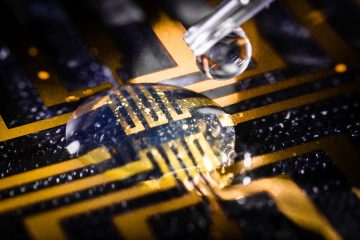NEW STUDY. Researchers at the Department of Chemistry & Molecular Biology at University of Gothenburg are partners in a research collaboration that successfully has grown electrodes in living tissue using the body’s molecules as triggers. The result, published in the journal Science, paves the way for the formation of fully integrated electronic circuits in living organisms.
Linking electronics to biological tissue is important to understand complex biological functions, combat diseases in the brain, and develop future interfaces between man and machine. However, conventional bioelectronics, developed in parallel with the semiconductor industry, have a fixed and static design that is difficult, if not impossible, to combine with living biological signal systems.

To bridge this gap between biology and technology, researchers have developed a method for creating soft, substrate-free, electronically conductive materials in living tissue. By injecting a gel containing enzymes as the “assembly molecules”, the researchers were able to grow electrodes in the tissue of zebrafish and medicinal leeches.
“For several decades, we have tried to create electronics that mimic biology. Now we let biology create the electronics for us,” says Professor Magnus Berggren at the Laboratory for Organic Electronics, LOE, at Linköping University.
No need for genetic modification
The body’s endogenous molecules are enough to trigger the formation of electrodes. There is no need for genetic modification or external signals, such as light or electrical energy, which has been necessary in previous experiments. The Swedish researchers are the first in the world to succeed in this.

Their study paves the way for a new paradigm in bioelectronics. Where it previously took implanted physical objects to start electronic processes in the body, injection of a viscous gel will be enough in the future.
In experiments conducted at Lund University, the team successfully achieved electrode formation in the brain, heart, and tail fins of zebrafish. The animals were not harmed by the injected gel and were otherwise not affected by the electrode formation. One of the many challenges in these trials was to take the animals’ immune system into account.
Inspired by the electronic rose

“The zebrafish is an excellent model for the study of organic electrodes in brains,” says Roger Olsson, professor at the University of Gothenburg and Lund University.
It was Professor Roger Olsson who took the initiative for the study, after he read about the electronic rose developed by researchers at Linköping University in 2015. One research problem, and an important difference between plants and animals, was the difference in cell structure. Whereas plants have rigid cell walls which allow for the formation of electrodes, animal cells are more like a soft mass. Creating a gel with enough structure and the right combination of substances to form electrodes in such surroundings was a challenge that took many years to solve.
“At the University of Gothenburg, we redesigned the chemistry of the electronically conductive materials to better fit the cell structure in animals rather than plants”, says Roger Olsson.
Article: Metabolite-induced in vivo fabrication of substrate-free organic bioelectronics
BY: LINKÖPING UNIVERSITY & UNIVERSITY OF GOTHENBURG











